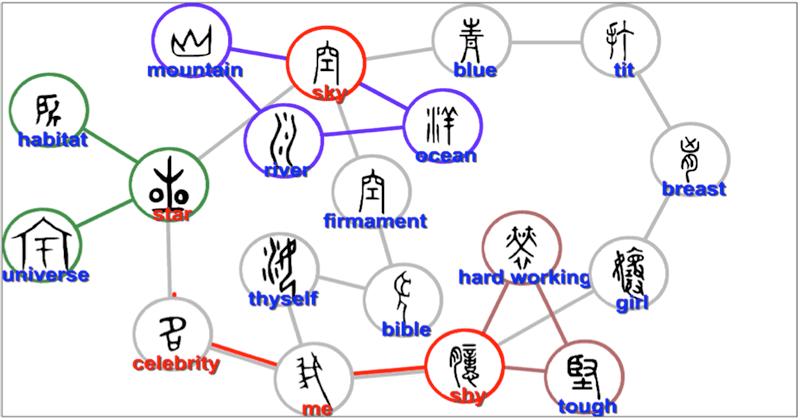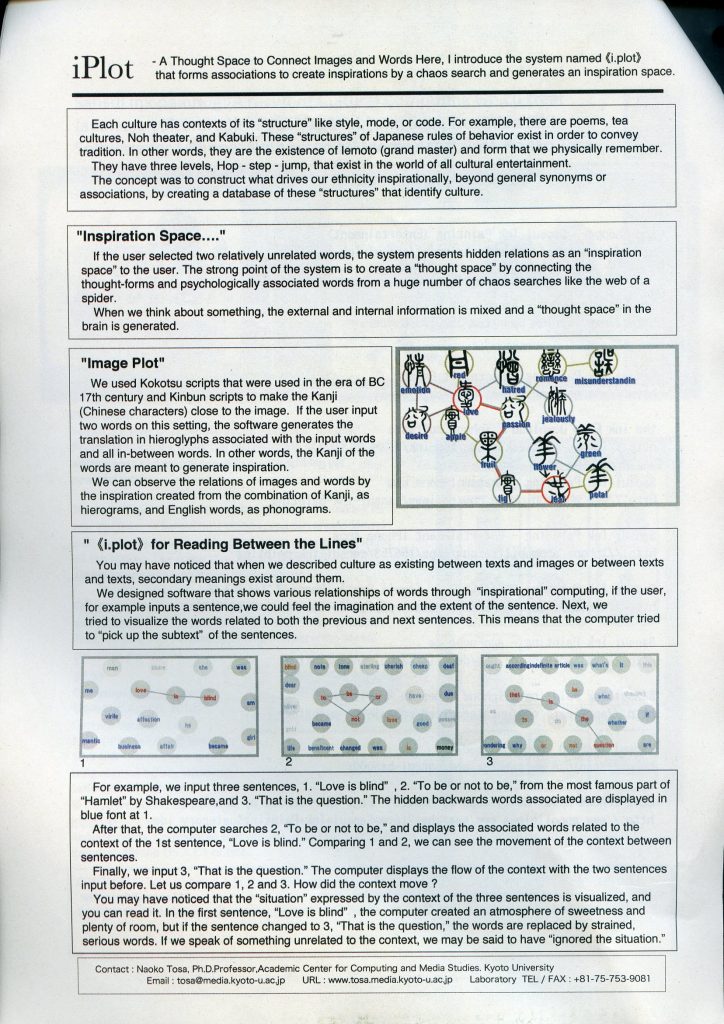
i.plot: Reading Between the Lines
We designed software that shows various relationships of words through “inspirational” computing, if the user, for example inputs a sentence, we could feel the imagination and the extent of the sentence. Next, we tried to visualize the words related to both the previous and next sentences. This means that the computer tried to “pick up the subtext” of the sentences.

Demo

Summary
The future of narrative in a project that studies the hidden relationships and contextual emergence of language.
Art and Science
In the history of art-and-science research, which began in the late 1960s, one aspect that has received insufficient attention is the field’s relationship to literature (narrative), perhaps because technological factors discouraged literature specialists from approaching the field. But now that the use of computers as an inter-medium is finally beginning to mature, it has possible for men and women of letters to get closer to computers. This project uses “the future of narrative” as a theme to research how computers can offer humor, wisdom, and inspiration. So far, art-and-science research projects have focused mainly on nonverbal communication modes, such as feeling and atmosphere. In i.plot, the logical meaning of language and its intuitive aspects, such as atmosphere and feeling, have been joined together.
Goal
A future of narrative that can generate interactive literature and scripts for interactive cinema.
Innovations
1. Inspiration Space
This system discovers the hidden connections between words. It determines that a connection between words exists if two words are found in the same thought-form or make up a stimulus-response pair in the Edinburgh Associative Thesaurus. Then it finds several connections between the two words by tracing a large set of possible paths between them, so that the paths traverse several two-word connections. If the chaos engine is in an appropriate state, a preference may be added so that longer paths are displayed, or so that the paths are forced to connect through a more distantly connected word. The user may further expand the connections of any word of interest.
2. Inspiration Restaurant Guide
A restaurant guide based on the inspiration system was built from France Telecom’s Yellow Pages database. Each of the restaurant categories and locations in Paris was entered into the system and connected to related words (pizzeria: italian food, tomato; creperie: date, sweets; fast food: quick, cheap). Users select (or ask the system to select) a location and input their preferences for restaurant atmosphere. A set of words appears, and users can select any word that appears on the screen. The system searches for a restaurant type closely related to that word, and a nearby restaurant of that type is displayed on the screen.
3. Context Inspiration
Using data obtained from the open database WordNet (Princeton University) as well as manual categorization, the words in the database were classified according to their grammatical properties in six categories: who, what, where, when, how, and verb. Users seed the system with a few idea words. The system then generates a sentence of various lengths ranging from two to five words (minus articles, conjunctions, etc.) based on these input words. Wherever there is a blank space in the sentence, the system fills it in, seeking words inspirationally linked to the words surrounding the space.
4. Symbol Inspiration
Rather than attaching symbols to existing word associations, the system applies a set of associations directly between symbols. These associations are based on the thought-forms explained above, where connections are based on geometric forms. Users can seed the engine by entering words linked to images in the input textboxes or by clicking one of the colored thought-form buttons at the top of the screen.
5. Inspiration Blog
The blog system allows the system to accept complete sentences as input. Connections between key words in the sentence are all considered, and intersecting words are displayed on the screen. The connections between each entry and the preceding entry are also included, so that the context generated within each entry is continuous.
6. Robot Agent Interface
The robot’s emotional expression and synthesized voice are automatically generated in accordance with the inspirational word context. When users interact with the inspiration system, the key words are extracted by the system and converted into behaviors via language-emotion mapping and sent to the robot over a Bluetooth connection.
Vision
The next phase of interaction technology and expression between computers and humans will focus on interactive narrative methods. Routine human-computer interactions still generate many logical, boring experiences. This project, because it provides inspiration containing humor and wisdom, offers people new opportunities for stimulation and symbiosis It seems certain that in the future, through the addition of narrative technology to art and science, a new, creative “interactive narrativity” will develop and generate a new era of human-machine collaboration.
Contributors
Seigow Matsuoka
Editorial Engineering Lab
Michihiko Minoh
Brad Ellis
Kyoto University
Ryohei Nakatsu
Kansai Gakuin University
Henry Tomas
Christian Warocquier
France Telecom
Exhibition
| 時間 | 2005 07/27 ~ 08/05 |
| 場所 | Los Angeles Convention Center Los Angeles, California USA |
| 内容 | SIGGRAPH 05 Emerging Technologies |